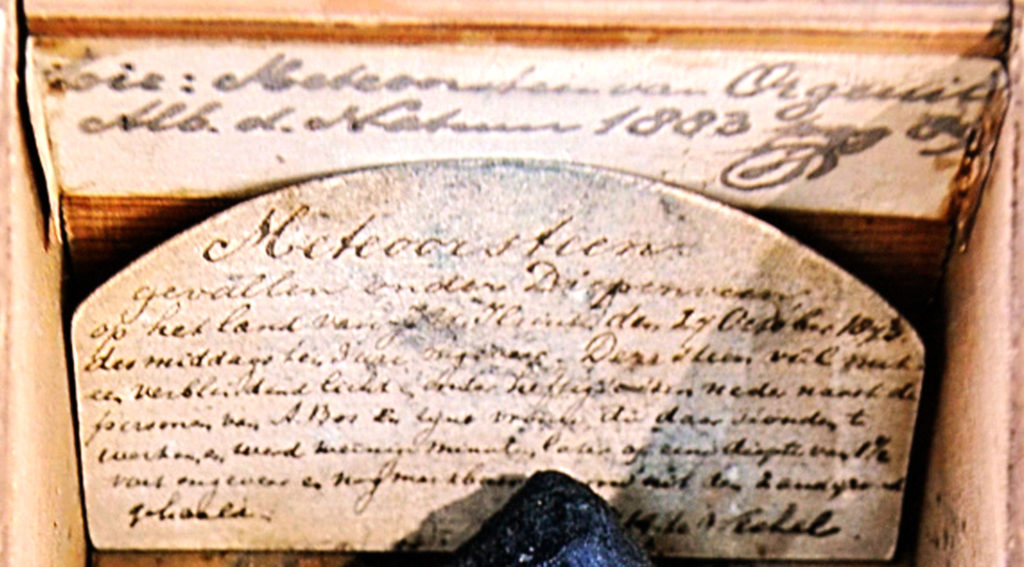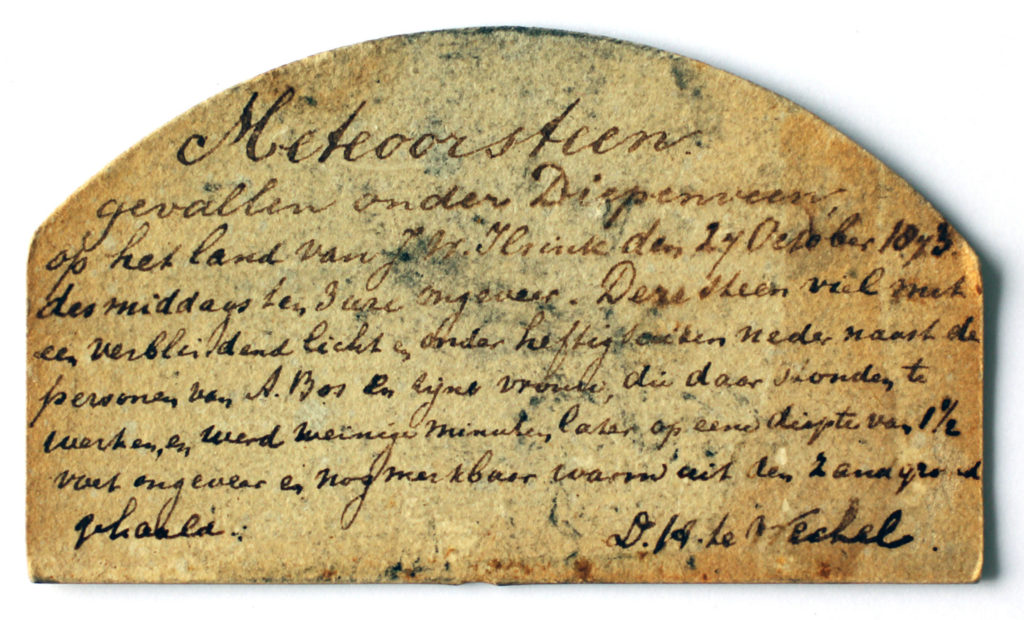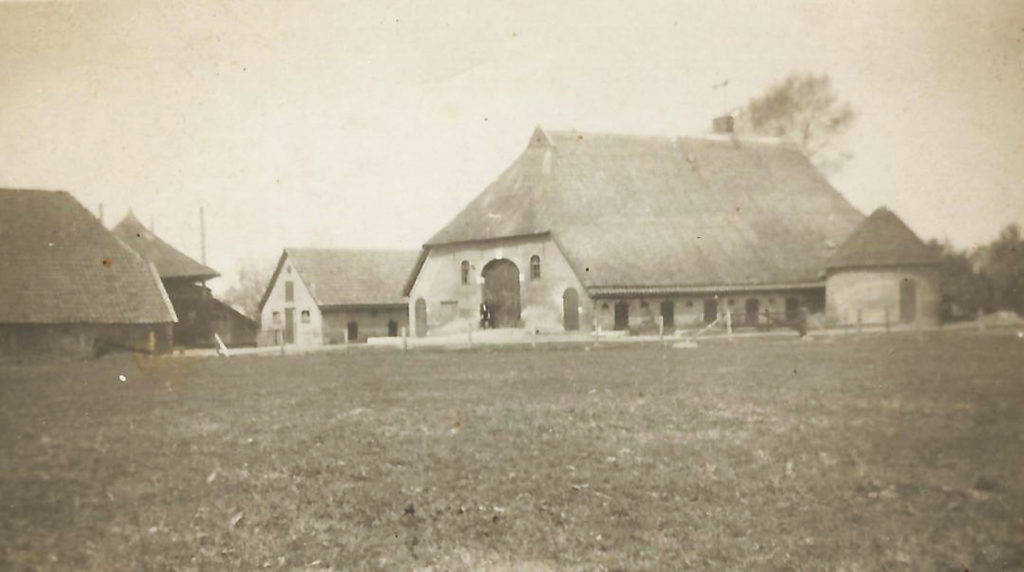Diepenveen
Probable meteorite fall (CM-anomalous, 68.4 g) in Rande near Diepenveen, Deventer, Overijssel, Netherlands on 27 October 1873 at ~ 3 p.m. local time

Diepenveen meteorite. Photo: Naturalis
The fall and the meteorite’s journey through time
The Diepenveen meteorite fall on Monday 27 October 1873 at 3 p.m. local time was witnessed by 33-year-old farm hand (boerenarbeider) Albertus Bos (*27 April 1840-1927) and his 31-year-old wife Johanna Nooteboom (*1 March (June ?) 1842-1923) who were working as temporary laborers on the farm of 78-year-old land owner Jan Willem Ilsink (18 March 1795-1878) close to the meteorite’s fall location in the hamlet (buerschap) and estate (landgoed) Rande, about 1.5 km west-northwest of the village Diepenveen in the eastern Netherlands. Jan Willem Ilsink and his wife Fenneken Bloemendal (until 1851) were the tenants of the Bloemendaal farm in Sallandsweg 1 from about 1840 to 1878. The meteorite is reported to have impacted and entered the sandy ground to a depth of about 45 centimeters at an unknown location within a perimeter of not more than 400 meters around location 52°17’35.0″N 6°07’31.1″E. It is reported that the meteorite was still warm when taken out of the impact pit. Bos and his wife lived a 30- to 45-minute walk away from the farm in the same street and only a few houses away from 39-year old Hendrik Jacobus Cornet (*21.2.1834) who had moved to Diepenveen on 2 February 1867 and was the hoofdonderwijzer (head teacher) of the school in Diepenveen. The meteorite was probably given to him by Albertus and Johanna shortly after the fall. Hendrik Jacobus Cornet had married the widow Gerharda Berkhoff in Diepenveen on 2 July 1868. At that time Gerharda already had a 22-year old son called Derk Hermann te Wechel from a previous marriage with A. te Wechel, another teacher from Diepenveen, who had died in 1866. It can be assumed that Cornet later gave the Diepenveen meteorite to his stepson Derk. He probably understood that the stone was in fact a ‘meteoorsteen’, a meteorite. Later Derk Hermann te Wechel brought the meteorite to the Rijks Hogere Burgerschool (HBS), a Higher Civilian State School in Deventer where he had studied and graduated. Since Te Wechel left for Delft in October 1874 to become a math teacher, then returned to Diepenveen in May 1877 to marry and then left again in October 1877 to go to Wageningen to work as a biologist at the Rijks Landbouwschool, it can be assumed that the meteorite was given to HBS at some time during those four years between October 1873 and October 1877.
At HBS Te Wechel’s former physics teacher J. Sirks took care of the meteorite and probably built the box out of spruce wood for it. The collection card containing Te Wechel’s name was likely written by HBS director Leendert A. J. Burgersdijk, based on an analysis of handwritings. The card is the only source of information concerning the impact event near Rande, east of Diepenveen. There are apparently no other historical records or newspaper articles about the meteorite fall. The second handwritten label which contains the line ‘Meteoorsteen van Orgueil’ was probably written by J. Sirks, D.H. te Wechel’s physics teacher at HBS, after the year 1883, based on an analysis of handwritings. Sirks is reported to have often used objects from the school’s collection during outreach events to the public in Deventer. Sirks had understood the similarity to the carbonaceous chondrite (CI) Orgueil which fell in France in 1864. The second line ‘Album der natuur 1883 pag 89’ refers to the article De meteoorsteenen by Dr. F. W. Krecke published in the popular science magazine Album der natuur: Een Werk ter Versppreiding van Natuurkennis onder beschaafde lezers van Allerlei Stand (Volume 32, No. 1) in 1883 (Harting, P., et al., eds.), which was popular among school teachers at the time. The article contains an engraved illustration of G. Daubrée’s 1867 drawing of the 2-kg main mass of the Orgueil meteorite on page 89. The Diepenveen meteorite was stored in the attic within HBS’s collection of educational tools and objects and was passed on when the school moved to Burgerdijkstraat and merged with another one. With the introduction of the Education Act (Mammoetwet), the school closed down in 1968. Several teachers took collection items home to save them from destruction. The 37-year-old teacher Jelle Jager (*8.3.1931) took the meteorite home and kept it until his death in November 2009. His wife Ali Bijl found the meteorite among his belongings and gave it to her camping friend Leida Kiers from Zwartemeer who was known for collecting rocks and minerals.

Signatures of Albertus Bos (*27 April 1840) and his wife Johanna Nooteboom (*1842) in Diepenveen in 1868.
Henk Nieuwenhuis’s rediscovery of the Diepenveen meteorite in 2012
Henk Nieuwenhuis, the former director and curator of the Royal Eise Eisinga Planetarium in Franeker, and Leida Kiers were neighbors at the camping site in Wielen in North Rhine-Westphalia on the German side of the Dutch-German border in the summer of 2012. On 11 August 2012, between 11 am and 3 pm. , 138 years, nine months and fifteen days after the Diepenveen fall, the camping site organized its Kunstroute, an exhibition of 18 creative campers who intended to present their hobbies. Nieuwenhuis and his wife were exhibiting photographs and paintings and Kiers was exhibiting paintings and a small collection of stones and fossils. While looking at Kiers’s stone collection Nieuwenhuis noticed the wooden box and read the handwritten card in it. He took several photos of the box and asked Kiers where she had got it from. Kiers told him that she had been given the box by Ali Jager but did not know where she had got it from. Nieuwenhuis was immediately certain that it was a carbonaceous chondrite because only half a year before in 2011 he had learned about meteorites because a small meteorite exhibition had been organized in the Eise Eisinga Planetarium in Franeker, which showed some carbonaceous meteorites* owned and provided by some dedicated Dutch meteorite collectors. Back home Nieuwenhuis phoned Mrs Jager who told him that her husband got it from the HBS and had kept it on his desk in his office.
On 28 August 2012 Nieuwenhuis contacted Niek de Kort, chairman of the Royal Netherlands Association for Meteorology and Astronomy (KNVWS), who was sceptical at first. On 29 August Nieuwenhuis sent photos of the meteorite and de Kort became interested. On 7 October de Kort contacted archaeologist Dr Marco Langbroek and sent him some photos. On 22 October de Kort and Langbroek visited Nieuwenhuis at his home in Franeker and confirmed that it was indeed a carbonaceous chondrite. Nieuwenhuis asked Liers to provide the meteorite for some initial analyses and donate a small fragment of it for research. In January 2013 Wim van Westrenen then carefully cut off small fragments weighing about 1 gram with a razor blade so that thick and thin sections could be made from a 0.58-gram fragment . Langbroek initiated the meteorite’s scientific analysis (electron microprobe and EDX ) at the Faculty of Earth Sciences at the Free University (VU) in Amsterdam where it was researched and classified by Prof. Dr. Wim van Westrenen and Marco Langbroek in cooperation with international research institutes, as NASA Ames Research Center, UC Berkeley and the University of New Mexico for the analysis of oxygen isotopes. All the names of the people who are mentioned on the collection card were researched by Niek de Kort and could be found in historical archives of Deventer. On 31 Dec 2015 Diepenveen was registered as probable fall, CM2-anomalous, in the Meteoritical Bulletin Database (MB 104). An international consortium of researchers with the VU headquarters in Amsterdam has since been investigating many more aspects of the meteorite, including its organic components. The first results of this study were initially expected to be published in mid-2014 but were not published until 13 May 2019.
The donation
Nieuwenhuis convinced Liers to donate this meteorite to the Naturalis Biodiversity Center in Leiden so that it could be exhibited to the public and is available for scientific research. On the 12th December 2013 at 11:30 a.m. Kiers donated the ‘Diepenveen’ meteorite to the Naturalis and received a specimen of the Allende meteorite in return. Since then the Diepenveen meteorite (RGM.818649) has been within the Naturalis collection, where it will be accessible for further research.
“Ja, er zijn mensen die me voor gek verklaren. Die zeggen dat de meteoriet misschien wel een ton waard is. Maar wat heb ik daaraan als toch niemand ‘m koopt? Nu geef ik hem aan de wetenschap, dat is toch veel mooier.” ( Leida Kiers )
Translation: “Yes, there are people who think I’m crazy. They say that the meteorite might be worth a ton. But what good is it if nobody buys it? Now I give it to science, that is much nicer.” [1 ton = 100.000 Gulden]
The meteorite
The Diepenveen meteorite, which is between 50 and 66 per cent covered with fusion crust, is not completely intact and rather brittle. Some fragments are clearly missing. Either they broke off in course of time or somebody had tried to split the meteorite in two by using a chisel. It is equally imaginable that the meteorite broke on impact. The two fragments (~ 55.4 and ~ 13 grams) of the meteorite were glued back together some time in the past and the glue marks can still be seen on its surface today.
A 3D model of the Diepenveen meteorite (by Delft Meteorite Lab) can also be found HERE.
The box
HBS collection card and label

The original collection card and label in the box. Photo: Henk Nieuwenhuis

The handwritten original collection card (max. 7.48 (width) x 4.45 cm (height)). Photo: Marco Langbroek
Meteoorsteen
gevallen onder Diepenveen op het land van J.W. Ilsink, den 27e October 1873 des middags ten drie ure ongeveer. Deze steen viel met een verblindend licht, onder heftig sissen neder naast de personen van A. Bos en zijne vrouw, die daar stonden te werken, en werd weinige minuten later op een diepte van 1 ½ voet ongeveer en nog merkbaar warm uit den zandgrond gehaald. – D.H. te Wechel
Transcript of the text on the collection card.
Meteor Stone
fallen near Diepenveen on the land of J. W. Ilsink on the 27th of October 1873 at approximately 3 o’clock in the afternoon. This stone fell with a blinding light and strong whistling sounds, close to the persons of A. Bos and his wife, who were working there, and was recovered from the sandy soil just few minutes later, from a depth of about 1.5 feet, and still noticeably warm. – D.H. te Wechel.
The weather in Diepenveen in the afternoon of 27 October 1873
It was Jacob Kuipers, meteorologist at Koninklijk Nederlands Meteorologisch Instituut (KNMI), who researched the weather on 27 October 1873. On that afternoon at 2 p.m. with ‘a moderate northerly flow’ it was (partially) cloudy and mostly dry. The air temperature was about 8.5° to 9.5° Celsius. The ground level pressure near Diepenveen was 122.5 hPa. It is possible that a daytime bolide was visible.
The approximate fall location near the Bloemendaal farm in Rande
The meteorite fell on sandy ground near a nowadays protected farm, known as as Erve Bloemendaal, in Sallandsweg 1 (once house number 64) in Rande, which had already existed before it became the property of the Vrouwenklooster (Women’s Monastry), established in 1400, of the Zusters des Gemenen Levens (Sisters of Common Life) in 1510. After the destruction of the Monastry starting in 1578 the farm came into the possession of the municipality of Deventer. In 1821 the municipality sold the farm. From about 1840 to 1878 Jan Willem Ilsink was the tenant of the farm and in 1886 the farm with its 28 hectares of land was sold for 18,000 guilders to the Roetert family. In 1935 1.5 hectares of land were sold.

Erve Bloemendaal farm in the early 20th Century, photographed from Sallandsweg. The thatched house is from the second half of the 18th Century. The round karnhuisje in the photo was demolished in 1949. Photo: Roetert collection
Scientific literature
The CM carbonaceous chondrite regolith Diepenveen
Marco Langbroek, Peter Jenniskens, Leo M. Kriegsman, Henk Nieuwenhuis, Niek De Kort, Jacob Kuiper, Wim Van Westrenen, Michael E. Zolensky, Karen Ziegler, Qing‐Zhu Yin, Matthew E. Sanborn, Josh Wimpenny, Akane Yamakawa, Sebastiaan J. De Vet, Matthias M. M. Meier, Kees C. Welten, Kunihiko Nishiizumi, Marc W. Caffee, Aaron S. Burton, Jason P. Dworkin, Daniel P. Glavin, Qinghao Wu, Richard N. Zare, Alexander Ruf, Mourad Harir, Philippe Schmitt‐Kopplin, The Diepenveen Meteorite Consortium
Meteoritics & Planetary Science
First Published: 13 May 2019
“A carbonaceous chondrite was recovered immediately after the fall near the village of Diepenveen in the Netherlands on October 27, 1873, but came to light only in 2012. Analysis of sodium and poly‐aromatic hydrocarbon content suggests little contamination from handling. Diepenveen is a regolith breccia with an overall petrology consistent with a CM classification. Unlike most other CM chondrites, the bulk oxygen isotopes are extremely 16O rich, apparently dominated by the signature of anhydrous minerals, distributed on a steep slope pointing to the domain of intrinsic CM water. A small subset plots closer to the normal CM regime, on a parallel line 2 ‰ lower in δ17O. Different lithologies in Diepenveen experienced varying levels of aqueous alteration processing, being less aqueously altered at places rather than more heated. The presence of an agglutinate grain and the properties of methanol‐soluble organic compounds point to active impact processing of some of the clasts. Diepenveen belongs to a CM clan with ~5 Ma CRE age, longer than most other CM chondrites, and has a relatively young K‐Ar resetting age of ~1.5 Ga. As a CM chondrite, Diepenveen may be representative of samples soon to be returned from the surface of asteroid (162173) Ryugu by the Hayabusa2 spacecraft.”
Write-up in Meteoritical Bulletin Database (31 December 2015): LINK
“Diepenveen 52° 17′ 35″N, 6° 7′ 30″E
Overijssel, Netherlands
Probable fall: 1873
Classification: Carbonaceous chondrite (CM2, anomalous)
History: (M. Langbroek, Naturalis and DMS, N. de Kort, KNVWS): A single 68-g stone in private ownership of Mrs. Leida Kiers was recognized as a meteorite by retired Royal Eise Eisinga director Henk Nieuwenhuis in 2012. A late 19th century handwritten card signed by D. H. Te Wechel, son of the 1873 Diepenveen village teacher, is preserved with the meteorite. It describes how the meteorite fell on 27 October 1873, near 3 pm local time, in an agricultural field near Diepenveen village. It fell near farmhand A. Bos and his wife, who reportedly recovered it within ‘ of the fall. The owner of the land is mentioned as J. W. Ilsinck, allowing to trace the fall location to within a few hundred meters through historic archives. The meteorite entered the curiosity collection of the Rijks HBS (Higher Civilian State School) of Deventer shortly after the fall and resided there for over a century. When the school permanently closed down in the 1970s, the meteorite and accompanying documentation were rescued from destruction by a teacher, Mr. Jager. After his death, it entered the private rock collection of Mrs. Kiers, who donated the meteorite to NBC in October 2013. All persons and places mentioned have been traced in historical archives.
Physical characteristics: (M. Langbroek, NBC): Upon rediscovery in 2012, the single preserved stone consisted of a fresh-looking 68.4 g half individual with a break surface and approximately 50% mostly shiny black fusion crust. The interior is dark grey-black with light spots. It is very crumbly. A small several grams detached fragment of the individual stone was glued back to it at an unknown date (perhaps shortly after the fall).
Petrography (L.M. Kriegsman, Naturalis): The meteorite is a breccia with angular clasts of different lithologies measuring up to 1 mm. The different lithologies vary with regards to chondrule rim thickness, and hydration level of matrix. Chondrules make up 15–20 vol% of the mass. Chondrule size is mostly between 0.05 and 0.7 mm with a mean of 0.35 mm, one measured as large as 1.8 mm. Most chondrules are porphyritic, only very few barred chondrules are present. They have fine grained dust mantles, locally showing alteration to tochilinite. The matrix contains Fo grains up to 0.4 mm, as well as amoeboid olivine aggregates and CAIs dominated by fassaite with perovskite in the core. Pyroxenes show two types: low-Ca pyroxene (monoclinic state confirmed by Raman) and fassaite. Matrix metals: 2-6 vol% of the matrix is metal and sulfides. FeNi grains occasionally measure up to 0.5 mm. All FeNi metal is kamacite with up to 2 wt% Cr and 1 wt% P. Magnetite is absent. Rare, tiny carbonate grains are present.
Geochemistry: Mineral compositions (EPMA and SEM-EDS) and geochemistry (L.M. Kriegsman, NBC; K. Ziegler, UNM; M. Zolensky, JSC; W. van Westrenen, VU Amsterdam;): Fa9±13 (chondrules, N=23), Fa35±10 (matrix, N=5), 70 (barred, rare, N=1); Fs2±1Wo2±2 (low-Ca pyroxene, N=8), Fs1.8±0.2Wo44±4 (fassaite, N=5). Oxygen isotopes (17 measurements): δ17O = -12.42, -12.75, -12.25, -11.88, -11.90, -11.19, -11.03, -9.55, -8.41, -7.36, -5.98, -4.31, -1.93, 0.30, -1.17, -0.24, -0.04 (range -12.748 to +0.301), δ18O = -10.33, -10.14, -9.59, -9.58,-9.22,-8.27,-8.15,-6.80,-5.24,-4.34,-2.11, 2.50, 5.55, 5.77, 5.93, 6.95, 7.69 (range -10.328 to +7.698), Δ17O = -6.96, -7.40, -7.19, -6.83, -7.03, -6.82, -6.73, -5.96, -5.64, -5.07, -4.86, -5.63, -4.86, -2.75, -4.30, -3.91,-4.10 (range -7.396 to -2.746). Some lithologies have more Fe-rich olivine: Fa38-64 (average Fa53, N=9), and their matrices contain significantly less phyllosilicates that the remainder of the meteorite.
Classification: CM2-anomalous. The classification as anomalous is based on the oxygen isotopic data, which are outside the range of CM bulk samples. This meteorite also hosts metal in the matrix, rarely observed in normal CM2 chondrites, suggesting a more reduced character for this meteorite.
Specimens: Main mass (66.6 g) at NBC. Thin section at JSC.”




































